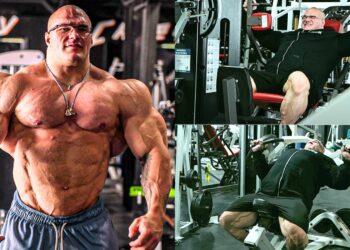Don’t worry, no donkeys are harmed (or involved) during this exercise. The name comes from the setup and performance of this movement that was made popular by old-school legends like Arnold Schwarzenegger who’d have one, and many times multiple people sit on his back while he did calf raises.
But we’ve come so far since the Golden-Era of bodybuilding and there are actually several variations of the donkey calf raise (we’ll get to that shortly) available today including machines made specifically for it (ooh… fancy).
Anyhow, calves are one of the most neglected muscles but that doesn’t mean you should forget about them too. While these lower leg muscles might be stubborn, they can be improved and are very important especially if you’re an athlete. The real advantage of the donkey calf raise is that it provides a pronounced stretch on the muscles and this is a key component of development.
In this guide, we’ve explained how to do the donkey calf raise with tips, variations, and information on the best way to include it in your calf workouts.
Here’s a guide to the donkey calf raise…
Muscles Worked
The donkey calf raise is a calf muscle exercise although, depending on the variation and amount of weight used, the core muscles are also engaged. But primarily, we do it to build diamond-shaped calves.
Level Up Your Fitness: Join our 💪 strong community in Fitness Volt Newsletter. Get daily inspiration, expert-backed workouts, nutrition tips, the latest in strength sports, and the support you need to reach your goals. Subscribe for free!
Gastrocnemius
The gastrocnemius is the biggest calf muscle that resembles a bulky slab on the lower leg below the knee. It also has two heads; medial and lateral. The gastrocnemius intersects both the knee and ankle joint and therefore functions at both ends, although it primarily works with the soleus to plantarflex the foot (points the toes down) when the knee is straight.
Gastrocnemius also houses more fast-twitch fibers than the soleus which is better for fast and explosive movements such as sprinting and jumping.
Soleus
Hidden to the gastrocnemius below the knee area, the soleus forms with the larger calf muscles to form the achilles tendon at the heel. It only crosses the ankle joint unlike the gastrocnemius and functions to plantarflex the foot when the knee is bent.
The soleus also plays a significant role in supporting posture and has more slow-twitch fibers that are better suited toward endurance-type activities.
Core
The core muscles are engaged to keep the torso flat and lower back protected when handling weight loads. Primarily, the deeper core muscles like the transverse abdominis.
How To Do The Donkey Calf Raise
Alright, so you learned what muscles are worked during the donkey calf raise and now it’s time to do it. Because there are so many different variations, we’ve provided instructions for what we believe to be the most common.
- Step onto an elevated platform of your choice (e.g., weight plates, spotting platform, blocks, etc) with your heels hanging off.
- Keeping your legs straight, hinge forward at the hips and lean onto a bench or something similar so that your torso is parallel to the floor.
- Allow your heels to lower until your feel a decent stretch in your calves and then push your toes down to raise your heel. Hold this position for a second or two and repeat.
Here’s a video example…
Related: 9 Best Calves Exercises
Donkey calf raise tips
- Make sure to setup your feet so that you can get a full range of motion in your ankles.
- You could also wear a weighted belt for this variations to add more resistance.
- Ideally, the knees should be kept straight to maximize involvement of the gastrocnemious.
4 Variations
We mentioned variations and we’re going to give them to you. Nowadays there are various options thanks to the progression of knowledge over the last several decades but also because of the machines that make it possible.
Here are four variations of the donkey calf raise that we recommend.
Level Up Your Fitness: Join our 💪 strong community in Fitness Volt Newsletter. Get daily inspiration, expert-backed workouts, nutrition tips, the latest in strength sports, and the support you need to reach your goals. Subscribe for free!
Related: Best Old-School Calf Workouts & Exercises
Donkey calf raise machine
Some gyms have a dedicated donkey calf raise machine while most probably don’t, especially the non-commercial gyms. But if you do have access to one then consider yourself lucky because it’s designed specifically for this awesome movement.
Smith machine version
The smith machine is another piece of equipment that you can use to add weight to this exercise. Typically, weight plates are used to elevate your toes and ensure a full range of motion. In addition, a bench or something is placed in front so that you can lean on it for support.
Traditional donkey calf raise
Alright, so you may look crazy but if you’re one of those crazy people who just don’t give a crap what others think, then have your partner jump on your back and start pumping out reps.
Leg press calf raise
The leg press calf raise places you at a similar angle as the donkey calf raise and therefore could be considered a variation. You have to place your toes on the bottom edge of the platform so that your heels are hanging off to ensure you’re getting a decent range of motion.
We don’t recommend going too heavy with these though because of how the leg press is designed.
How To Include The Donkey Calf Raise Into Your Training Routine
The best way to include the donkey calf raise in your training is to do it alongside your other calf exercises. Because after all, it is a calf exercise.
If done using completely straight legs, the donkey calf raise emphasizes the gastrocnemius. Therefore, if you were going to choose one other calf exercise to do, it should be done with bent knees such as the seated machine calf raise to target the soleus.
Although, there really aren’t a ton of variations as far as calf exercises go. So you’ll either do a standing or seated variation. But every workout that you train calves, include both a standing and seated calf exercise.
Read: Calf Exercises – Standing Vs Seated Calf Raise
Sets/reps
We recommend 2-4 sets of 15-20 reps for the donkey calf raise using heavier poundages. The calves can be a very stubborn muscle and sometimes they need a lot of reps with heavy weight to force a growth response.
Try this 6-minute calf workout.
Wrapping Up
The donkey calf raise is a great exercise to add to your calf training arsenal. It may not be appropriate to do it the traditional way anymore (unless you just don’t care) but as you saw today, there are other effective variations of that you can do instead.
Interested in measuring your progress? Check out our strength standards for Seated Calf Raise, Machine Calf Raise, Donkey Calf Raise.








